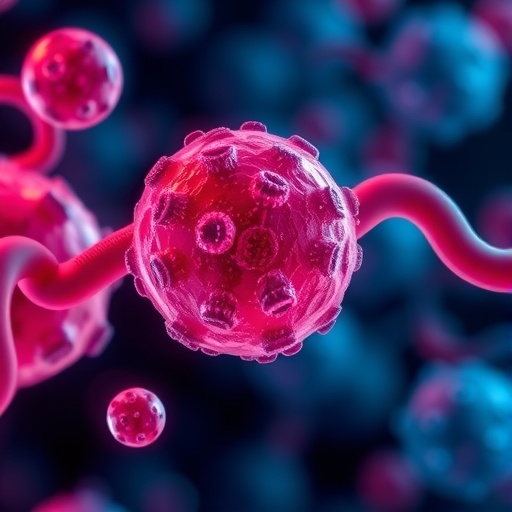Recent research has highlighted the complex interplay between environmental pollutants and reproductive health, with a powerful focus on two common endocrine disruptors: di(2-ethylhexyl) phthalate (DEHP) and bisphenol A (BPA). These chemicals, pervasive in everyday products, have drawn attention for their potential roles in the development of polycystic ovary syndrome (PCOS), a condition that affects 5-10% of women of reproductive age. A significant new study, led by Li et al., delves into the molecular mechanisms and targets associated with DEHP and BPA exposure, expanding our understanding of how these substances contribute to the prevalence of PCOS.
At the heart of this investigation is network toxicology, a tool that’s gaining traction within the field of environmental health. This approach allows researchers to map out the intricate interactions between various biological systems and the external chemical exposures that may disturb their balance. By employing this framework, the study unveils how DEHP and BPA disrupt normal hormone functions, leading to the symptomatic manifestations of PCOS. This molecular docking study reveals how these chemicals can bind to critical receptors, ultimately changing the very course of ovarian function.
The implications of these findings extend well beyond the laboratory. With an increasing number of products containing DEHP and BPA, awareness of their potential health impacts is crucial. Women who may be at risk for PCOS, particularly those diagnosed with metabolic syndrome, should be made aware of these chemicals in the context of their reproductive health. The ramifications of exposure can manifest in a myriad of ways, including insulin resistance, obesity, and inflammation—all factors that further exacerbate the symptoms of PCOS.
One of the most alarming aspects of this study is the suggestion that the effects of DEHP and BPA may not be limited to direct exposure. The researchers demonstrated that these chemicals can produce multi-generational impacts, suggesting that the reproductive health of future generations could be compromised by current environmental standards. This layer of complexity underscores the importance of revisiting and possibly revising regulatory guidelines on chemical exposures, particularly for women and children.
Moreover, the use of molecular docking methods in this research has unlocked new frontiers in understanding how DEHP and BPA interact at the cellular level. This technique simulates the binding of these chemicals to cellular receptors, demonstrating not only affinity but also the potential downstream biological effects. Such insight provides a dual function: it serves to inform both the scientific community and public health officials about the urgent need for preventive measures against endocrine disruptors.
The timing of this research is particularly poignant with the growing scrutiny on plastic use and other synthetic compounds in daily life. Manufacturers and consumers alike are called to action; the study notes a striking demand for safer alternatives to conventional plastics and chemicals. The push for ‘green chemistry’ initiatives may offer promising paths toward replacing harmful substances without sacrificing efficacy.
In addition to advancing our comprehension of PCOS and its relationship with environmental pollutants, the findings of Li et al. resonate with discussions surrounding climate change and its cascading effects on public health. As the planet warms, it is conceivable that stressors—including chemical exposures—will intensify, thus further amplifying the risks associated with reproductive health disorders. Furthermore, as nations strive to reduce carbon footprints, a parallel effort must be made to clean up hazardous waste streams entering ecosystems, particularly those impacting women’s health.
With a bold focus on the research community, the article emphasizes that studies like this serve to galvanize action. It calls for interdisciplinary cooperation among toxicologists, reproductive biologists, and health policymakers. The goal is straightforward: to craft comprehensive strategies that can counteract the effects of harmful pollutants. Raising awareness through educational campaigns, advocating for better regulations, and supporting research into alternative materials are crucial steps that must be undertaken collectively.
In conclusion, the study by Li et al. serves as a pivotal contribution to our understanding of how common chemicals disrupt reproductive health, specifically in the context of PCOS. By elucidating the molecular underpinnings and potential health threats posed by DEHP and BPA, this research provides a clarion call to investigate further. If we are to safeguard future generations’ reproductive health, urgent action is necessary—both within the scientific field and among regulatory bodies. The task lies ahead, and the time for change is now.
In summary, the ongoing dialogue surrounding environmental health, reproductive rights, and public safety takes on renewed significance in light of these findings. DEHP and BPA are reminders of the critical intersection of our everyday choices and the broader implications for health. As society turns its gaze towards healthier practices, the knowledge gained from this landmark research will fuel advocacy and innovation in both science and industry.
Subject of Research: The impact of DEHP and BPA exposure on polycystic ovary syndrome (PCOS) through network toxicology and molecular docking.
Article Title: Unveiling the potential targets and mechanisms of DEHP/BPA exposure on PCOS: insights from network toxicology and molecular docking.
Article References:
Li, Y., Jiang, Y., Zhu, B. et al. Unveiling the potential targets and mechanisms of DEHP/BPA exposure on PCOS: insights from network toxicology and molecular docking.
J Ovarian Res 18, 268 (2025). https://doi.org/10.1186/s13048-025-01866-1
Image Credits: AI Generated
DOI: https://doi.org/10.1186/s13048-025-01866-1
Keywords: DEHP, BPA, PCOS, network toxicology, molecular docking, reproductive health.




